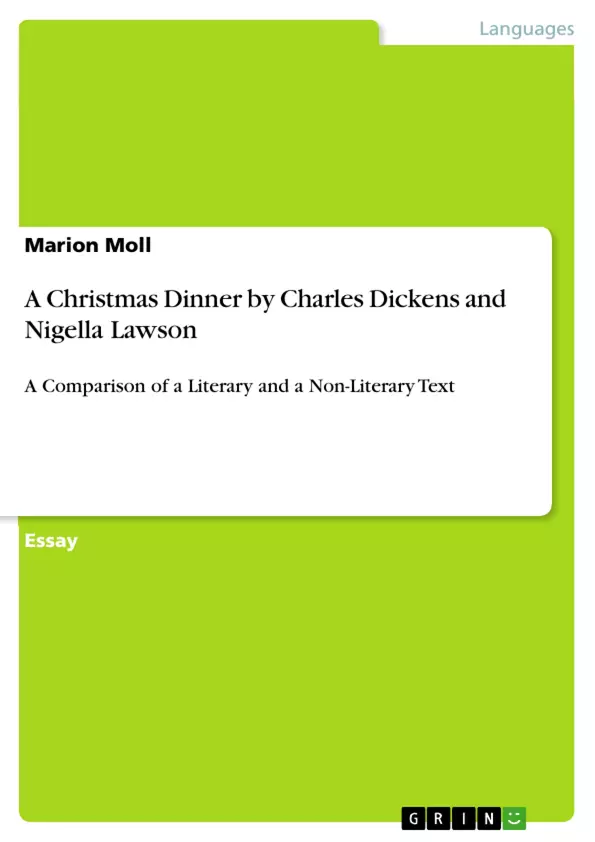These two texts are descriptions of Christmas dinners. The first one is a literary one, an excerpt taken out of Charles Dickens’ novel “A Christmas Carol”, first published in 1843. The second one is an introduction to a collection of recipes in an online blog by Nigella Lawson from 2012.
Even though it might seem at first that they are quite similar texts as they are both about the same specific event, there are a lot of differences to be found. This essay will discuss the differences and similarities between the two texts and analyse and compare them using a number of theories of textual analysis: Karl Bühler’s Organon Model, Paul Grice’s Conversational Maxims, and Michael Halliday and Ruqaiya Hassan’s Context of Situation. It should be noted that even when the vocabulary used has a slightly negative connotation, for example flouting or lack of, this in no way means that one text is superior to the other or that the aspect mentioned is in fact a negative one. The vocabulary used is only to describe and analyse, not to judge the two texts.
The two texts are descriptions of Christmas dinners. The first one is a literary one, an excerpt taken out of Charles Dickens’ novel “A Christmas Carol”, first published in 1843.The second one is an introduction to a collection of recipes in an online blog by Nigella Lawson from 2012. Even though it might seem at first that they are quite similar texts as they are both about the same specific event, there are a lot of differences to be found. This essay will discuss the differences and similarities between the two texts and analyse and compare them using a number of theories of textual analysis: Karl Bühler’s Organon Model, Paul Grice’sConversational Maxims, and Michael Halliday and Ruqaiya Hassan’s Context of Situation. It should be noted that even when the vocabulary used has a slightly negative connotation, for example flouting or lack of, this in no way means that one text is superior to the other or that the aspect mentioned is in fact a negative one. The vocabulary used is only to describe and analyse, not to judge the two texts.
The first theory with which the two texts will be analysed and compared is the organon model according to Bühler. It has been formulated by Karl Bühler and consists of three communication functions of language that help describe any kind of communication. The three functions are the Expressive, Representative and Appellative functions, all identified by Bühler (1934 ; Translation 2011). Innis (1982) argues that this model was the foundation of Bühler’s thought of language as an instrument to communicate knowledge about states of affairs or objects from one person to another.
An excerpt from A Christmas Carol by Charles Dickens is the first text to be analysed. Because this is a piece of literature and not an advertisement that wants to persuade people to do or buy something, there is not much of the Appeal or Signal function in this text. It can only be said that as it is a piece of literature, that is has been written for the general public with a few restrictions, for example people who know the English language and who can relate to having a Christmas dinner at home with their families. There is, however, a number of examples for the Expression or Symptom function as well as for the Representation or Symbol function. It could be argued that the Appeal function is somewhat hidden in the Expression function, as it is how the author wants the reader to see the atmosphere and characters.
[...]
- Quote paper
- Marion Moll (Author), 2016, A Christmas Dinner by Charles Dickens and Nigella Lawson, Munich, GRIN Verlag, https://www.grin.com/document/383840



